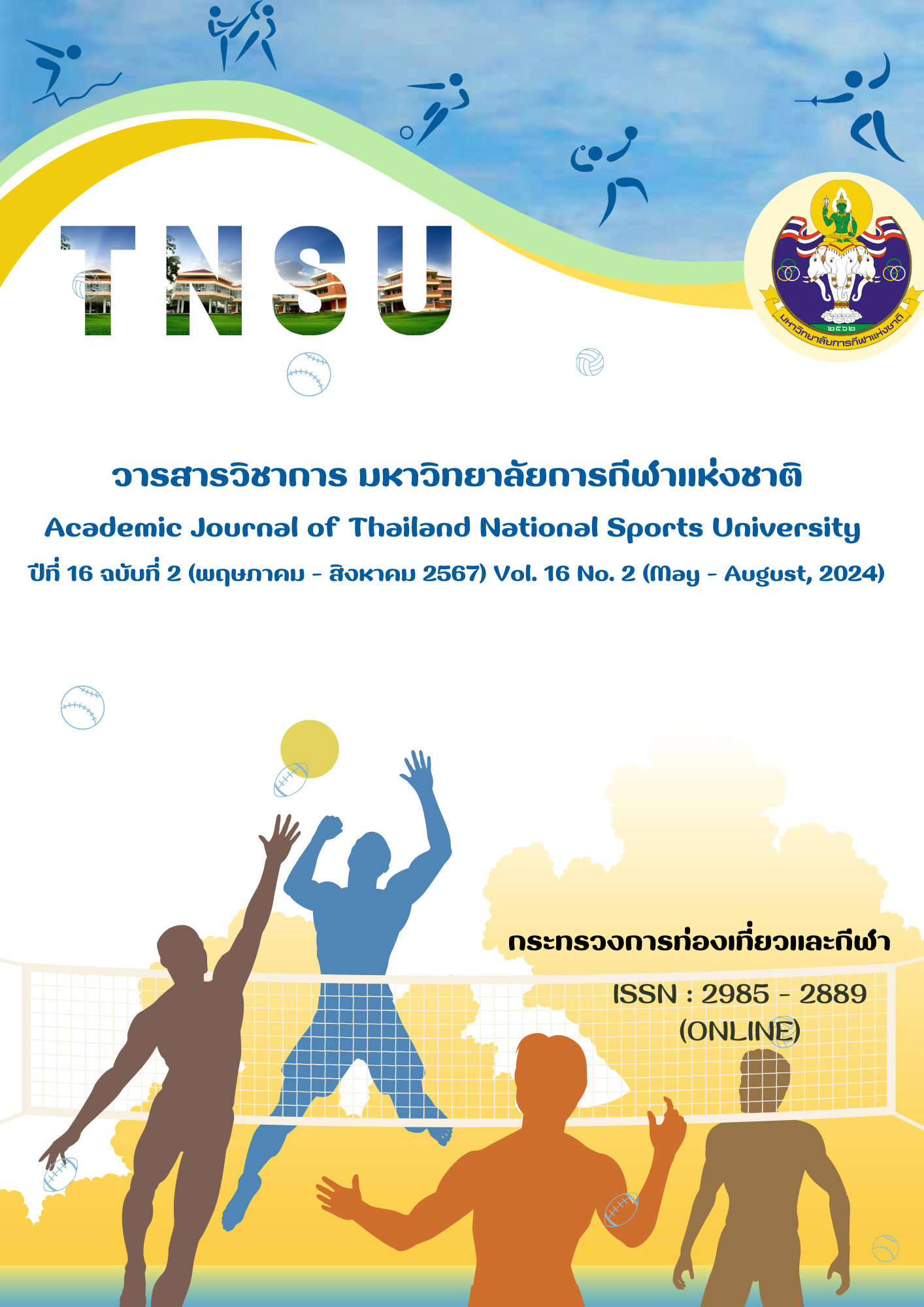THE EFFECT OF VISUAL AID TECHNIQUE ON GOLF PUTTING PERFORMANCE IN NON - EXPERIENCED ADOLESCENT MALES
Main Article Content
Abstract
The purposes of this study was to compare golf putting performance between visual aid practice versus normal putting practice in male adolescents who have no experience in playing golf. Forty-seven young male adolescents (aged 14.5±0.6 years) were randomly assigned into two groups: the visual aid group (n=24) and the normal putting group (n=23). Prior to the experiment, participants were measured for body height, weight, and body mass index. Ten putts pre-test were performed at baseline to determine absolute error and holed putts accuracy then both groups performed 50 putts. After two days, ten putts post-test were assessed for both groups and same distance at 2.5 meter all test. The differences between before and after the experiment in both within and between the groups were analyzed by Mixed ANOVA with Repeated Measurement (2x2 Group by Time Interaction Effect). Results showed that absolute error was significantly improved in both groups (p<.001), but not for holed putts (p=.085). No significant differences between the two groups after the experiment in both absolute error (p=.605) and holed putts (p=.436). In conclusion, visual aid and normal putting practice offer similar improvement in golf putting accuracy among adolescent male who had no experience in golf.
Article Details

This work is licensed under a Creative Commons Attribution-NonCommercial-NoDerivatives 4.0 International License.
The published article is a copyright of the Academic Journal of Thailand National Sports University. The passage appeared in each article in this academic journal is a perspective of each author which is not related to the journal. Each author is required to be responsible for all components of his/her own article. If there are any mistakes, each author must be responsible for those mistakes on his/her own.
References
Bahmani, M., Wulf, G., Ghadiri, F., Karimi, S., & Lewthwaite, R. (2017). Enhancing performance expectancies through visual illusions facilitates motor learning in children. Human Movement Science, 55, 1 – 7.
Bridge, M. W., & Middleton, N. (2018). PUTTING – A direction-distance problem. In M. Toms (Ed.). Routledge international handbook of golf science. (pp. 151 – 160). New York: Routledge.
Chauvel, G., Wulf, G., & Maquestiaux, F. (2015). Visual illusions can facilitate sport skill learning. Psychonomic Bulletin & Review, 22, 717 - 721.
Lee, T. D. (1988). Chapter 7 transfer - appropriate processing: A framework for conceptualizing practice effects in motor learning. Advances in psychology, 50, 201 - 215.
Palmer, K., Chiviacowsky, S., & Wulf, G. (2016). Enhanced expectancies facilitate golf putting. Psychology of Sport and Exercise, 22, 229 – 232.
Pelz, D. (2000). Dave Pelz’s Putting Bible. New York: Doubleday.
Pope, J., James, D., Wood, P., & Henrikson, E. (2014). The effect of skid distance on distance control in golf putting. Procedia Engineering, 72, 642 – 647.
Schmidt, R.A., and Wrisberg, C.A. (2008). Motor learning and performance: A situation - based learning approach (4th ed.). Champaign, IL: Human Kinetics.
Schmidt, R. A., Lee, T. D., Winstein, C. J., Wulf, G., & Zelaznik, H. N. (2018). Motor control and learning – A behavioral emphasis (6th ed.). Champaign, IL: Human Kinetics.
The Royal and Ancient Golf Club of St Andrews [The R&A]. (2019b). The rule of golf. Retrieved from https://www.randa.org/Rog/2019/Pages/The-Rules-of-Golf
Witt, J. K., Linkenauger, S.A., & Proffitt, D.R. (2012). Get me out of this slump! Visual illusions improve sports performance. Psychological Science, 23, 397 – 399.
Wood, G., Vine, S. J., & Wilson, M. R. (2013). The impact of visual illusions on perception, action planning, and motor performance. Attention, Perception, & Psychophysics, 75, 830 – 834.
Wulf, G., and Lewthwaite, R. (2016). Optimizing performance through intrinsic motivation and attention for learning: The optimal theory of motor learning. Psychonomic Bulletin & Review, 23, 1382 – 1414.
Ziv, G., Ochayon, M., and Lidor, R. (2019a). Enhanced or diminished expectancies in golf putting – which actually affects performance. Psychology of Sport and Exercise, 40, 82 - 86.
Ziv, G., Lidor, R., and Lavie, M. (2019b). Enhanced expectancies in golf putting – a replication study with increased ecological validity. International Journal of Sport and Exercise Psychology, 9(10). DOI: 10.1080/1612197X.2019.1637362.
Ziv, G., Lidor, R., Elbaz, L., & Lavie, M. (2020). Preference - performance dissociation in golf putting. Retrieved from https://doi.org/10.3389/fpsyg.2020.00102


